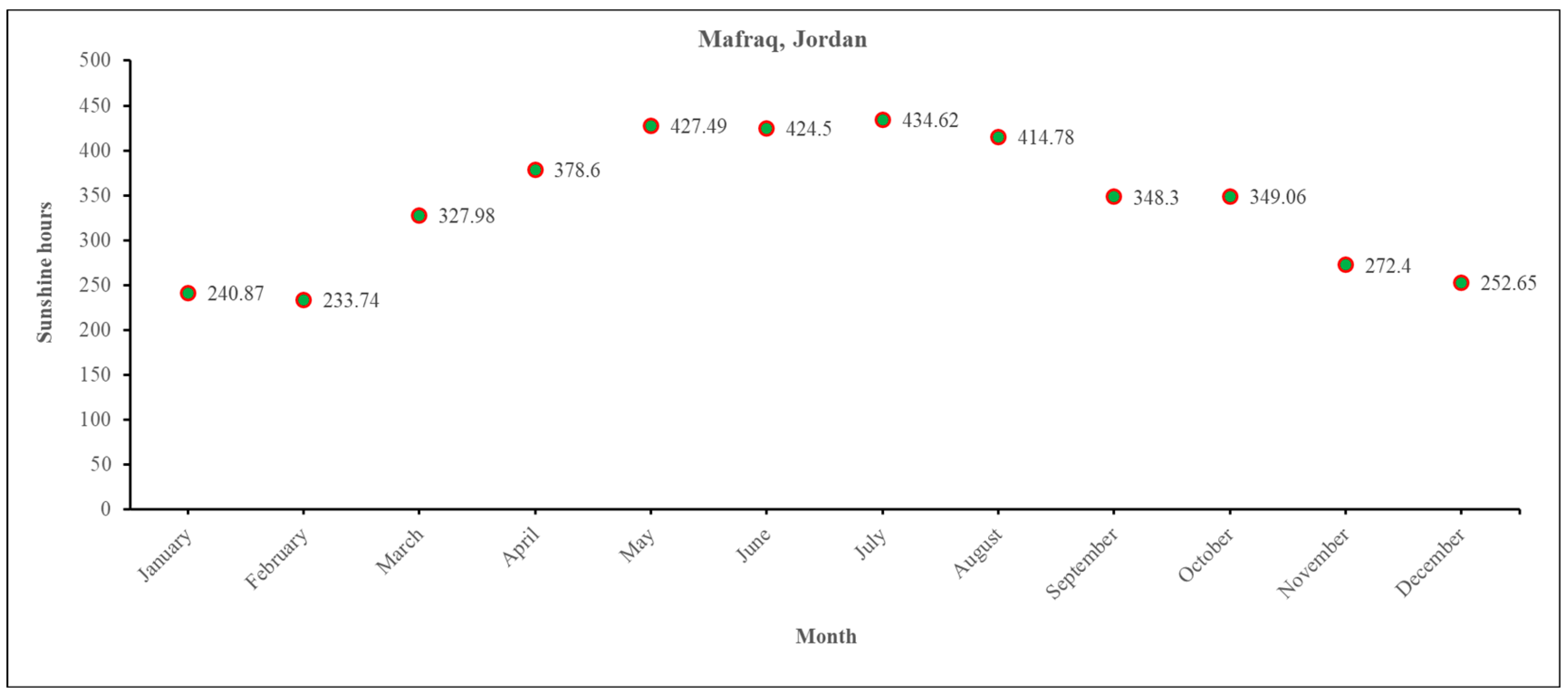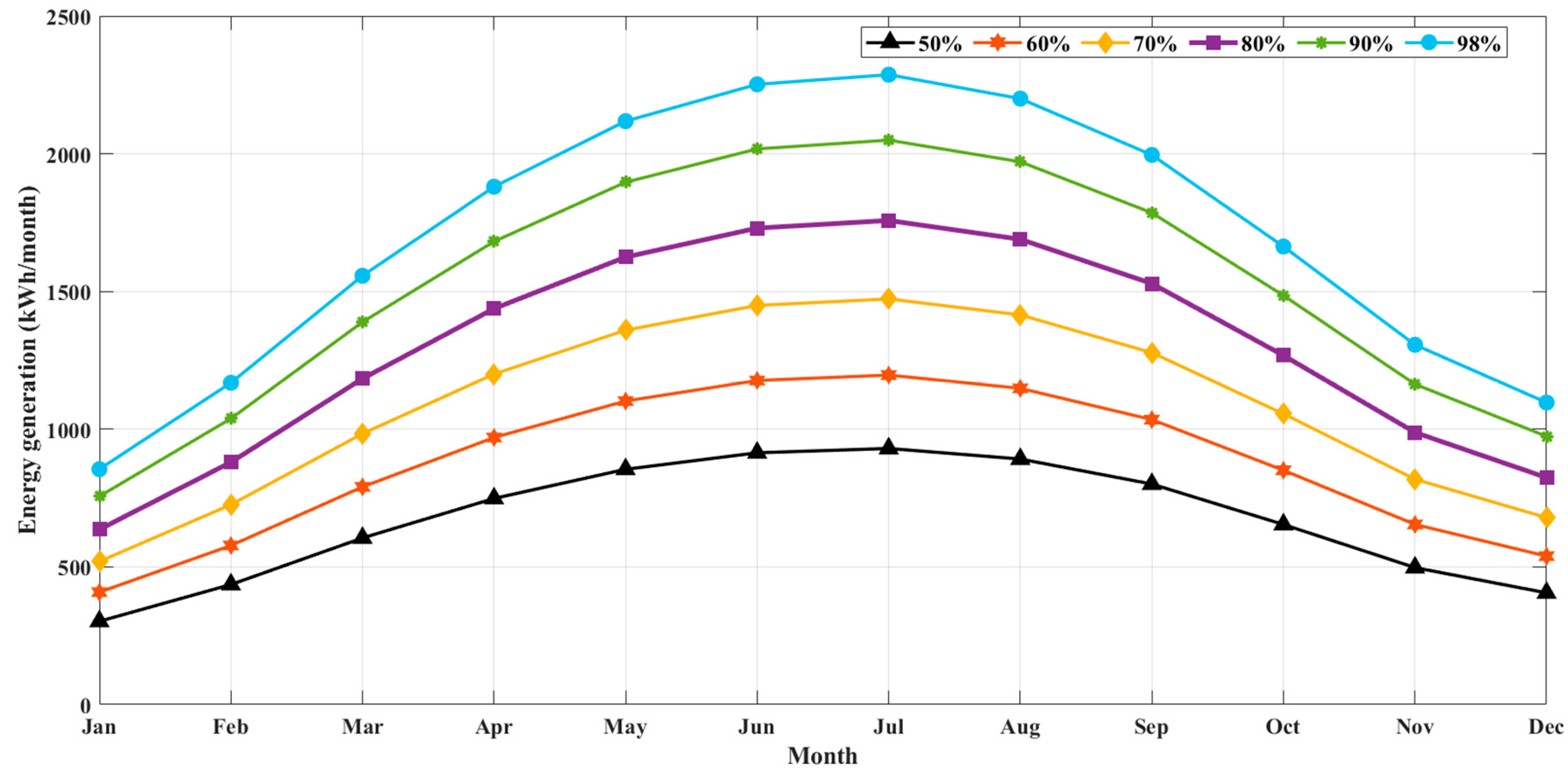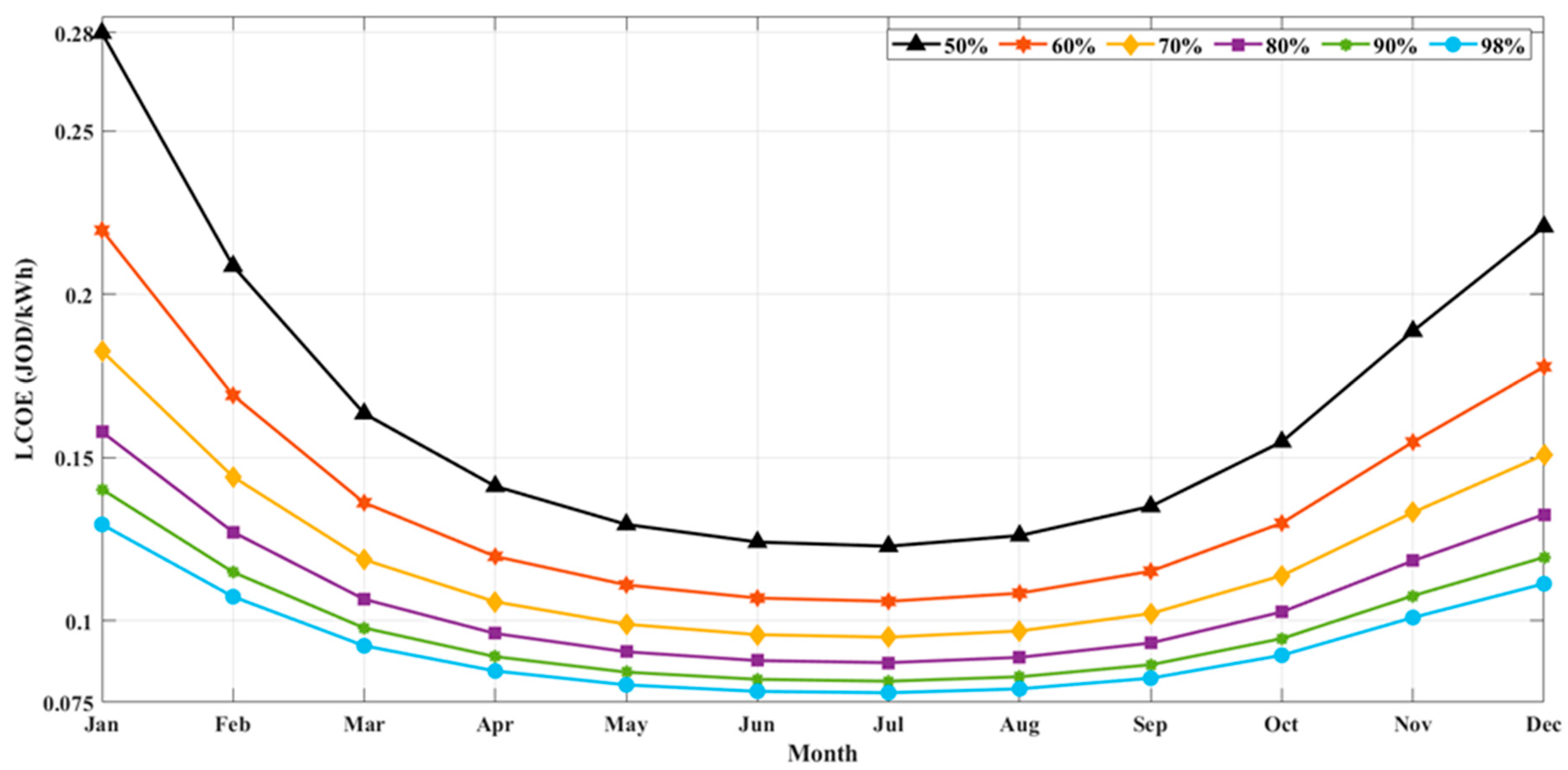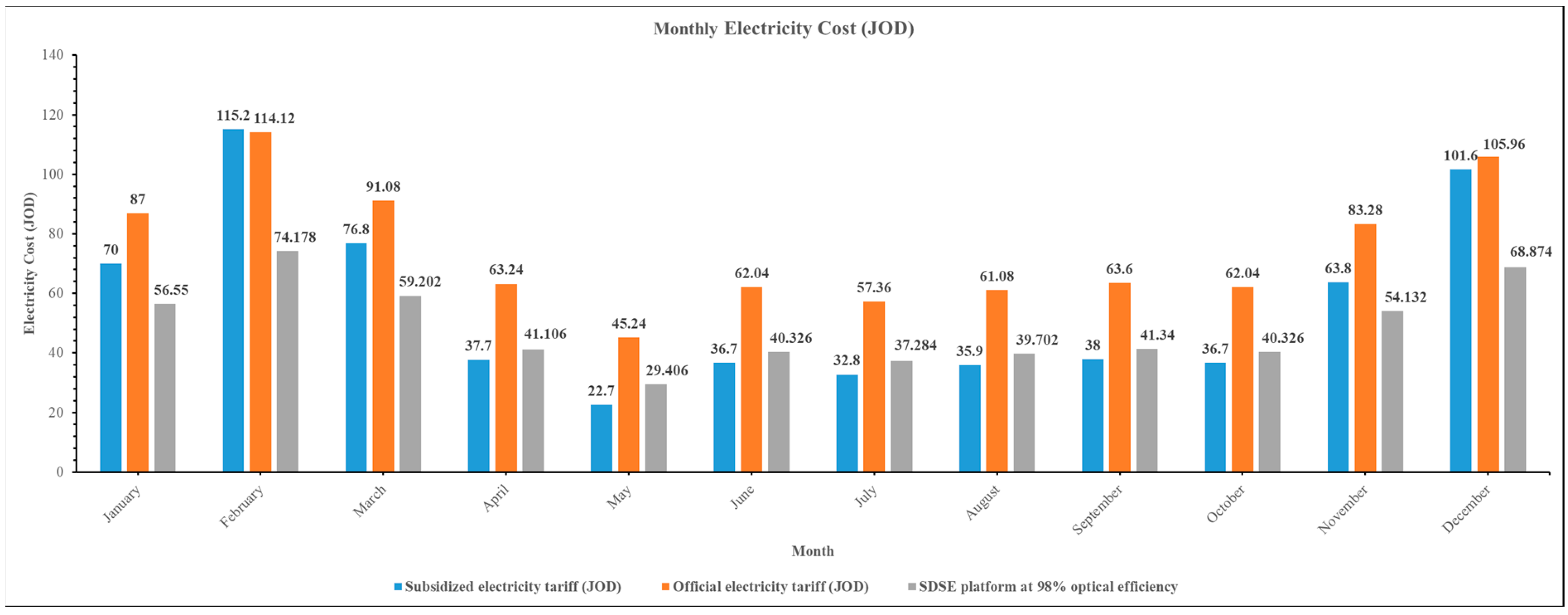Comparative Energy and Economic Analysis of Dish Stirling Engine and National Grid Electricity for Residential Building in Mafraq, Jordan
Abstract
1. Introduction
2. Methodology
2.1. Geographical Location
2.2. Methodology Data
2.3. Simulation Model
2.3.1. Modelling Toolbox
2.3.2. SDSE Analytical Model
- Due to their smallness, conduction heat exchanges at the point of reception are disregarded.
- There is no consideration for optical heat loss.
- The heat that the SE emits is disregarded.
- There are details on the receiver, concentrating device, and generation efficiency.
2.4. Economic Model
3. Results and Discussion
4. Conclusions
Author Contributions
Funding
Institutional Review Board Statement
Informed Consent Statement
Data Availability Statement
Conflicts of Interest
References
- IRENA. Geopolitics of the Energy Transformation: The Hydrogen Factor; IRENA: Abu Dhabi, United Arab Emirates, 2022. [Google Scholar]
- Khawaldeh, H.A.; Al-Soeidat, M.; Farhangi, M.; Lu, D.D.C.; Li, L. Efficiency Improvement Scheme for PV Emulator Based on a Physical Equivalent PV-Cell Model. IEEE Access 2021, 9, 83929–83939. [Google Scholar] [CrossRef]
- Khawaldeh, H.A.; Al-Soeidat, M.; Lu, D.D.-C.; Li, L. Fast Photovoltaic Emulator Based on PV-cell Equivalent Circuit Model. In Proceedings of the Energy Conversion Congress and Exposition—Asia, ECCE Asia 2021, Singapore, 24–27 May 2021. [Google Scholar] [CrossRef]
- Holechek, J.L.; Geli, H.M.E.; Sawalhah, M.N.; Valdez, R. A Global Assessment: Can Renewable Energy Replace Fossil Fuels by 2050? Sustainability 2022, 14, 4792. [Google Scholar] [CrossRef]
- Skea, J.; van Diemen, R.; Portugal-Pereira, J.; Al Khourdajie, A. Outlooks, explorations and normative scenarios: Approaches to global energy futures compared. Technol. Forecast. Soc. Chang. 2021, 168, 120736. [Google Scholar] [CrossRef]
- Al Naimat, A.; Liang, D. Substantial gains of renewable energy adoption and implementation in Maan, Jordan: A critical review. Results Eng. 2023, 19, 101367. [Google Scholar] [CrossRef]
- Monna, S.; Abdallah, R.; Juaidi, A.; Albatayneh, A.; Zapata-Sierra, A.J.; Manzano-Agugliaro, F. Potential Electricity Production by Installing Photovoltaic Systems on the Rooftops of Residential Buildings in Jordan: An Approach to Climate Change Mitigation. Energies 2022, 15, 496. [Google Scholar] [CrossRef]
- Hilpert, S.; Dettner, F.; Al-Salaymeh, A. Analysis of cost-optimal renewable energy expansion for the near-term jordanian electricity system. Sustainability 2020, 12, 9339. [Google Scholar] [CrossRef]
- Alrwashdeh, S.S. Energy sources assessment in Jordan. Results Eng. 2022, 13, 100329. [Google Scholar] [CrossRef]
- Altarawneh, N.A.; Murtadha, T.K. Managing engineering challenges in the design and implementation of eco-friendly residential structures. Results Eng. 2023, 19, 101363. [Google Scholar] [CrossRef]
- Al-Falahat, A.M.; Qadourah, J.A.; Alrwashdeh, S.S. Economic feasibility of heating source conversion of the swimming pools. J. Appl. Eng. Sci. 2022, 20, 276–284. [Google Scholar] [CrossRef]
- Qadourah, J.A. Energy and economic potential for photovoltaic systems installed on the rooftop of apartment buildings in Jordan. Results Eng. 2022, 16, 100642. [Google Scholar] [CrossRef]
- Altarawneh, O.R.; Alsarayreh, A.A.; Al-Falahat, A.M.; Al-Kheetan, M.J.; Alrwashdeh, S.S. Energy and exergy analyses for a combined cycle power plant in Jordan. Case Stud. Therm. Eng. 2022, 31, 101852. [Google Scholar] [CrossRef]
- Da Silva, R.P.P.; Amini, S. Energy, exergy and economic analysis for a combined cooling heat and power system: A case study for a university campus. Case Stud. Therm. Eng. 2023, 49, 103393. [Google Scholar] [CrossRef]
- Ren, Z.; Grozev, G.; Higgins, A. Modelling impact of PV battery systems on energy consumption and bill savings of Australian houses under alternative tariff structures. Renew. Energy 2016, 89, 317–330. [Google Scholar] [CrossRef]
- Ashtiani, M.N.; Toopshekan, A.; Astaraei, F.R.; Yousefi, H.; Maleki, A. Techno-economic analysis of a grid-connected PV/battery system using the teaching-learning-based optimization algorithm. Sol. Energy 2020, 203, 69–82. [Google Scholar] [CrossRef]
- Dhimish, M.; Ahmad, A.; Tyrrell, A.M. Inequalities in photovoltaics modules reliability: From packaging to PV installation site. Renew. Energy 2022, 192, 805–814. [Google Scholar] [CrossRef]
- Kut, P.; Pietrucha-Urbanik, K. Most Searched Topics in the Scientific Literature on Failures in Photovoltaic Installations. Energies 2022, 15, 8108. [Google Scholar] [CrossRef]
- Bhalkar, A.; Wadekar, A.; Wagh, M.; Dengle, S. Issues, challenges, and current lacunas in design, and installation of ground mounted solar PV module mounting structure (MMS). Mater. Today Proc. 2022, 58, 128–134. [Google Scholar] [CrossRef]
- Dalapati, G.K.; Ghosh, S.; Sherin, T.; Ramasubramanian, B.; Samanta, A.; Rathour, A.; Wong, T.K.S.; Chakrabortty, S.; Ramakrishna, S.; Kumar, A. Maximizing solar energy production in ASEAN region: Opportunity and challenges. Results Eng. 2023, 20, 101525. [Google Scholar] [CrossRef]
- Aboelmaaref, M.M.; Zhao, J.; Li, W.; Ali, E.S.; Askalany, A.A.; Ghazy, M.; Gu, L.; Zayed, M.E. Research on solar dish/Stirling engine driven adsorption-based desalination system for simultaneous co-generation of electricity and freshwater: Numerical investigation. Case Stud. Therm. Eng. 2023, 47, 103044. [Google Scholar] [CrossRef]
- Alhawsawi, A.; Zayed, M.E.; Moustafa, E.; Banoqitah, E.; Elsheikh, A.H. Hybridizing solar dish Stirling power system with single-effect desalination for sustainable electricity and freshwater co-generation: Mathematical modeling and performance evaluation. Case Stud. Therm. Eng. 2023, 45, 102997. [Google Scholar] [CrossRef]
- Khan, M.I.; Asfand, F.; Al-Ghamdi, S.G. Progress in research and technological advancements of commercial concentrated solar thermal power plants. Sol. Energy 2023, 249, 183–226. [Google Scholar] [CrossRef]
- Yan, J.; Peng, Y.D.; Liu, Y.X. Optical performance evaluation of a large solar dish/Stirling power generation system under self-weight load based on optical-mechanical integration method. Energy 2023, 264, 126386. [Google Scholar] [CrossRef]
- Zhang, L.; Han, K.; Wang, Y.; Zhu, Y.; Zhong, S.; Zhong, G. A bibliometric analysis of Stirling engine and in-depth review of its application for energy supply systems. Energy Rev. 2023, 2, 100048. [Google Scholar] [CrossRef]
- Arif, H.; Shah, A.; Ratlamwala, T.A.H.; Kamal, K.; Khan, M.A. Effect of Material Change on Stirnol Engine: A Combination of NiTiNOL (Shape Memory Alloy) and Gamma Stirling Engine. Materials 2023, 16, 3257. [Google Scholar] [CrossRef] [PubMed]
- Vaziri, B.; Azadi, M.; Biglari, M.; Madani, S.N. Simple-mix: Thermodynamics modeling in a Gama-type Stirling engine with a working fluid mixture. Eng. Rep. 2023, 5, e12656. [Google Scholar] [CrossRef]
- Aboelmaaref, M.M.; Zhao, J.; Zayed, M.E.; Li, Y.; Gu, L.; Askalany, A.A.; Ghazy, M.; Alsaman, A.S.; Ali, E.S. Design and dynamic numerical modeling of a hybrid reverse osmosis/adsorption-based distillation system driven by solar dish Stirling engine for enhanced performance and waste heat recovery. Process Saf. Environ. Prot. 2023, 180, 324–328. [Google Scholar] [CrossRef]
- Hammad, F.A.; Shalaby, S.M.; Zayed, M.E. Innovative design of a dome-shaped solar distiller enhanced with a multi-tray conical absorber basin and fountain feeding supply: Experimental study with energy, exergy, and enviro-economic analyses. Sol. Energy 2023, 266, 112183. [Google Scholar] [CrossRef]
- Ciulla, G.; Guarino, S.; Lanchi, M.; D’Auria, M.; De Lucia, M.; Salvestroni, M.; Di Dio, V. Hybridization solutions for solar dish systems installed in the Mediterranean region. Renew. Energy 2023, 217, 119112. [Google Scholar] [CrossRef]
- Gu, L.; Li, Y.; Zhong, S.; Shen, R.; Zheng, R.; Yang, D.; Zhao, J.; Li, H. Theoretical and experimental study on the heat collection of solar dish system based on adjustable receiver. Energy Convers. Manag. 2023, 291, 117250. [Google Scholar] [CrossRef]
- Al-Dafaie, A.M.A.; Dahdolan, M.E.; Al-Nimr, M.A. Utilizing the heat rejected from a solar dish Stirling engine in potable water production. Sol. Energy 2016, 136, 317–326. [Google Scholar] [CrossRef]
- Bataineh, K.; Taamneh, Y. Performance analysis of stand-alone solar dish Stirling system for electricity generation. Int. J. Heat Technol. 2017, 35, 498–508. [Google Scholar] [CrossRef]
- Al-Tahaineh, H.; Amer, K. Design of a solar dish water heater for desalting water. JP J. Heat Mass Transf. 2019, 18, 331–342. [Google Scholar] [CrossRef]
- Al-Amayreh, M.I.; Alahmer, A.; Manasrah, A. A novel parabolic solar dish design for a hybrid solar lighting-thermal applications. Energy Rep. 2020, 6, 1136–1143. [Google Scholar] [CrossRef]
- Shboul, B.; Ismail, A.A.; Michailos, S.; Ingham, D.; AL-Zoubi, O.H.; Ma, L.; Hughes, K.; Pourkashanian, M. Design and Techno-economic assessment of a new hybrid system of a solar dish Stirling engine instegrated with a horizontal axis wind turbine for microgrid power generation. Energy Convers. Manag. 2021, 245, 114587. [Google Scholar] [CrossRef]
- Bataineh, K.M. Optimization analysis of solar-powered average temperature Stirling heat engine. J. Energy South. Africa 2015, 26, 55–66. [Google Scholar] [CrossRef]
- Bataineh, K. Performance evaluation of a stand-alone solar dish Stirling system for off–grid electrification. Energy Sources Part A Recover. Util. Environ. Eff. 2022, 44, 1208–1226. [Google Scholar] [CrossRef]
- Shboul, B.; Al-Arfi, I.; Michailos, S.; Ingham, D.; Udeh, G.T.; Ma, L.; Hughes, K.; Pourkashanian, M. Multi-Objective Optimal Performance of a Hybrid CPSD-SE/HWT System for Microgrid Power Generation. In Applications of Nature-Inspired Computing in Renewable Energy Systems; Mellal, M.A., Ed.; IGI Global Publisher of Timely Knowledge: Hershey, PA, USA, 2021; pp. 166–210. [Google Scholar] [CrossRef]
- Al-Tahaineh, H. Performance Investigation of a Concentrated Solar Dish for Heating Applications. Jordanian J. Eng. Chem. Ind. 2023, 6, 1–6. [Google Scholar] [CrossRef]
- Al Tahaineh, H.; Hassan, W. Simulation-Design and Performance Analysis of a Small-Scale Generation. Jordan J. Mech. Ind. Eng. 2023, 17, 413–419. [Google Scholar]
- Alrwashdeh, S.S.; Ammari, H.; Jweihan, Y.S.; Qadourah, J.A.; Al-Kheetan, M.J.; Al-Falahat, A.M. Refurbishment of Existing Building toward a Surplus Energy Building in Jordan. Open Constr. Build. Technol. J. 2022, 16. [Google Scholar] [CrossRef]
- Forrousso, S.; Kaitouni, S.I.; Mana, A.; Wakil, M.; Jamil, A.; Brigui, J.; Azzouzi, H. Optimal sizing of off-grid microgrid building-integrated-photovoltaic system with battery for a net zero energy residential building in different climates of Morocco. Results Eng. 2024, 22, 102288. [Google Scholar] [CrossRef]
- Sreenath, S.; Sudhakar, K.; Yusop, A.F. 7E analysis of a conceptual utility-scale land-based solar photovoltaic power plant. Energy 2021, 219, 119610. [Google Scholar] [CrossRef]
- Akdeniz, H.Y.; Balli, O.; Caliskan, H. Energy, exergy, economic, environmental, energy based economic, exergoeconomic and enviroeconomic (7E) analyses of a jet fueled turbofan type of aircraft engine. Fuel 2022, 322, 124165. [Google Scholar] [CrossRef]
- Jordan Meteorological Department. Available online: http://jmd.gov.jo/en (accessed on 21 May 2024).
- Global Solar Atlas. December 2023. Available online: https://globalsolaratlas.info/map (accessed on 21 May 2024).
- Albatayneh, A.; Juaidi, A.; Abdallah, R.; Peña-Fernández, A.; Manzano-Agugliaro, F. Effect of the subsidised electrical energy tariff on the residential energy consumption in Jordan. Energy Rep. 2022, 8, 893–903. [Google Scholar] [CrossRef]
- Albatayneh, A.; Juaidi, A.; Manzano-Agugliaro, F. The Negative Impact of Electrical Energy Subsidies on the Energy Consumption—Case Study from Jordan. Energies 2023, 16, 981. [Google Scholar] [CrossRef]
- Lin, S.; Yao, W.; Xiong, Y.; Zhao, Y.; Shi, Z.; Ai, X.; Wen, J. MatPSST: A Matlab/Simulink-based power system simulation toolbox for research and education. IET Gener. Transm. Distrib. 2023, 17, 2272–2288. [Google Scholar] [CrossRef]
- Zhao, L.; Li, Z.; Ma, Y.; Qu, L. A novel cryptocurrency price time series hybrid prediction model via machine learning with MATLAB/Simulink. J. Supercomput. 2023, 79, 15358–15389. [Google Scholar] [CrossRef]
- Abu-Rumman, G.; Khdair, A.I.; Khdair, S.I. Current status and future investment potential in renewable energy in Jordan: An overview. Heliyon 2020, 6, e03346. [Google Scholar] [CrossRef] [PubMed]
- Al-Jaafreh, M.; Mokryani, G.; Asharaa, A.; Zubo, R. Techno-Economic Viability Test of Renewable Energy Supply Options in Developing Countries: Jordan Case Study. In Proceedings of the 1st International Multi-Disciplinary Conference Theme: Sustainable Development and Smart Planning, IMDC-SDSP 2020, Cyperspace, 28–30 June 2020. [Google Scholar] [CrossRef]
- Al-Jaraden, T.; Ayadi, O.; Alahmer, A. Towards sustainable shale oil recovery in Jordan: An evaluation of renewable energy sources for in-situ extraction. Int. J. Thermofluids 2023, 20, 100446. [Google Scholar] [CrossRef]









| Reference | Year | Measured Variables | Main Findings |
|---|---|---|---|
| Al-Dafaie et al. [32] | 2016 | Solar radiation, wind speed, humidity, temperatures. | Demonstrated using rejected heat from an SE for water distillation, showing high water production rates and cogeneration efficiency, especially beneficial for water-scarce regions like Jordan. |
| Bataineh and Taamneh [33] | 2017 | Solar insolation, temperatures, air density, sun angle, receiver parameters, engine conditions. | SDSE system has 21% efficiency (can improve by 3%); an ideal design can result in a 19% increase in yearly energy production; receiver losses account for 13% of solar radiation. |
| Al-Tahaineh and Amer [34] | 2019 | Water and ambient temperatures, absorber characteristics, efficiency. | Achieved 44% efficiency in solar dish water heater; efficiency decreases with higher temperatures due to radiation losses. |
| Al-Amayreh et al. [35] | 2020 | Solar panel performance, temperature, power output, separation distance impact. | The hybrid solar system has 23.62% efficiency; closer fiber optics separation increases power generation. |
| Shboul et al. [36] | 2021 | Efficiency, LCOE, power, area, and number of units. | SE efficiency: 37%, net output power 1500 kW–100 kW wind turbine, cost-effective with 0.2–0.24 power coefficient. LCOE: 0.09165–0.10575 JOD/kWh, hourly cost~2.82 JOD/h. Competitive with other renewables economically. |
| Bataineh [37] | 2021 | Overall system efficiency, power measurement, thermal efficiency, thermal system efficiency. | Achieved 32% overall system efficiency; provided design guidelines for a solar-powered dish. Stirling engines. |
| Bataineh [38] | 2022 | Overall system efficiency, optimal concentration ratio, and mechanical and electric energy conversion. | The electricity demand under varying solar irradiation has a monthly mean net conversion of energy that varies from summer to winter, around 22% to 30%. |
| Shboul et al. [39] | 2022 | Simulation results, system performance, and cost analysis. | The hybrid SDSE/wind system is feasible and competitive, with a total LCOE of about 0.1269 JOD/kWh and a payback period of one year. |
| Al-Tahaineh [40] | 2023 | Absorber temperature, time taken to reach an equilibrium temperature. | Solar dish water heater reached 246 °C in 1500 s; efficiency decreases with higher temperatures. |
| Al Tahaineh and Hassan [41] | 2023 | Operational parameters, output temperature, and system performance. | Optimal parameters: 0.004 m thickness, 0.92 reflectivity, 4.6 m/s wind speed; highest output temperature 289 °C at 75.5 concentration ratio. |
| Monthly Electrical Energy Consumption (kWh) | Subsidized Electricity Tariff (JOD/kWh) | Official Electricity Tariff (JOD/kWh) |
|---|---|---|
| 1–300 | 0.05 | 0.12 |
| 301–600 | 0.10 | 0.12 |
| 601–1000 | 0.20 | 0.12 |
| >1000 | 0.20 | 0.15 |
| Month | Consumption kWh/Month |
|---|---|
| January | 725 |
| February | 951 |
| March | 759 |
| April | 527 |
| May | 377 |
| June | 517 |
| July | 478 |
| August | 509 |
| September | 530 |
| October | 517 |
| November | 694 |
| December | 883 |
| Average | 622 |
| Annual (kWh/year) | 7467 |
| Data | Symbol | Unit | Value |
|---|---|---|---|
| Operating conditions | |||
| Operating hours | OH | h | 10 |
| Atmospheric pressure | Pa | bar | 1.0132 |
| Ambient temperature | Tamb | °C | 25 |
| Stirling engine parameters | |||
| Working fluid type | Carbon dioxide (CO2) | ||
| SE power | PSE | kW | 14–33 |
| High cycle temperature | Th | °C | 800 |
| Lower cycle temperature | Tl | °C | 15 |
| Dish diameter | Dc | m | 11 |
| Stroke | S | cm | 5 |
| Engine speed | V | rpm | 1800 |
| Dish concentrator parameters | |||
| Rim angle | ψr | degree | 37 |
| Receiver efficiency | ηr | % | 80 |
| Generator efficiency | ηgen | % | 95 |
| Concentrator efficiency | ηc | % | 97 |
| Economic Factors | |
| Parameter | Value |
| Annual interest rate (%) | 5 |
| SDSE lifetime (year) | 25 |
| Variable operating cost (JOD/kWh) | 0 |
| Direct Costs | |
| Initial investment cost of concentrator (JOD/m2) | 211.5 |
| Initial investment of receiver (JOD/kW) | 130.425 |
| Initial investment of Stirling engine (JOD/kW) | 260.85 |
| Indirect Costs | |
| Investment cost (JOD) | 0.141 of direct costs |
| O&M cost (JOD/kW) | 35.25 |
| Replacement cost (JOD) | 0.141 of direct costs |
| Data | Symbol | Value | Unit |
|---|---|---|---|
| Direct normal irradiation | DNI | 2448.2 | kWh/m2 |
| Global horizontal irradiation | GHI | 2127.8 | kWh/m2 |
| Diffuse horizontal irradiation | DHI | 596.1 | kWh/m2 |
| Ambient temperature | Ta | 20.3 | °C |
| Terrain elevation | h | 661 | m |
| Month | PSH (H/Month) | PSH (H/Year) |
|---|---|---|
| January | 4.59 | 142.31 |
| February | 5.18 | 145.11 |
| March | 6.08 | 188.54 |
| April | 6.74 | 202.3 |
| May | 6.97 | 215.99 |
| June | 7.29 | 218.62 |
| July | 7.36 | 228.06 |
| August | 7.46 | 231.19 |
| September | 7.36 | 220.84 |
| October | 6.57 | 203.56 |
| November | 5.57 | 167 |
| December | 4.72 | 146.43 |
| Average | 6.33 | 192.50 |
Disclaimer/Publisher’s Note: The statements, opinions and data contained in all publications are solely those of the individual author(s) and contributor(s) and not of MDPI and/or the editor(s). MDPI and/or the editor(s) disclaim responsibility for any injury to people or property resulting from any ideas, methods, instructions or products referred to in the content. |
© 2024 by the authors. Licensee MDPI, Basel, Switzerland. This article is an open access article distributed under the terms and conditions of the Creative Commons Attribution (CC BY) license (https://creativecommons.org/licenses/by/4.0/).
Share and Cite
Khawaldeh, H.A.; Shboul, B.; Al-Smairan, M.; Al-Soeidat, M.; Lu, D.; Almomani, F. Comparative Energy and Economic Analysis of Dish Stirling Engine and National Grid Electricity for Residential Building in Mafraq, Jordan. Sustainability 2024, 16, 5945. https://doi.org/10.3390/su16145945
Khawaldeh HA, Shboul B, Al-Smairan M, Al-Soeidat M, Lu D, Almomani F. Comparative Energy and Economic Analysis of Dish Stirling Engine and National Grid Electricity for Residential Building in Mafraq, Jordan. Sustainability. 2024; 16(14):5945. https://doi.org/10.3390/su16145945
Chicago/Turabian StyleKhawaldeh, Habes Ali, Bashar Shboul, Mohammad Al-Smairan, Mohammad Al-Soeidat, Dylan Lu, and Fares Almomani. 2024. "Comparative Energy and Economic Analysis of Dish Stirling Engine and National Grid Electricity for Residential Building in Mafraq, Jordan" Sustainability 16, no. 14: 5945. https://doi.org/10.3390/su16145945
APA StyleKhawaldeh, H. A., Shboul, B., Al-Smairan, M., Al-Soeidat, M., Lu, D., & Almomani, F. (2024). Comparative Energy and Economic Analysis of Dish Stirling Engine and National Grid Electricity for Residential Building in Mafraq, Jordan. Sustainability, 16(14), 5945. https://doi.org/10.3390/su16145945








